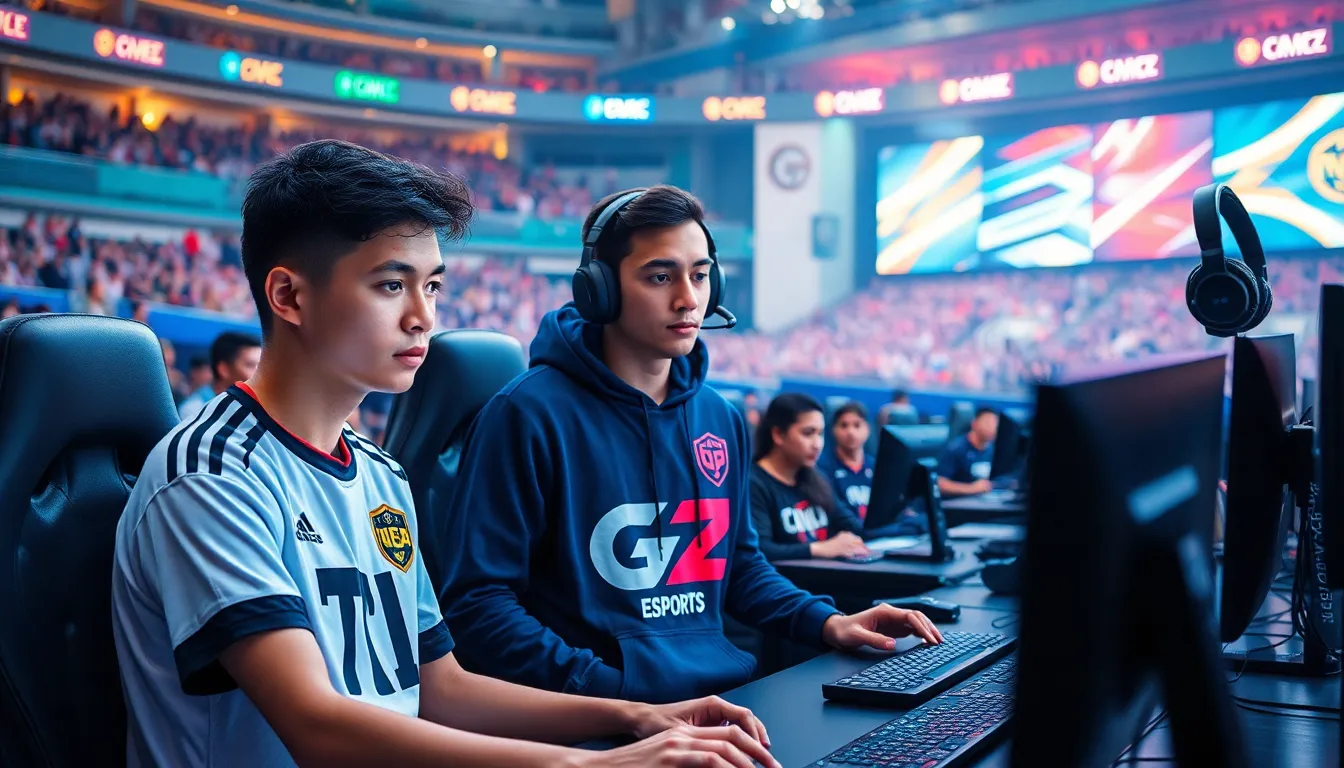In the electrifying world of esports, League of Legends reigns supreme, captivating millions with its thrilling gameplay and intense competition. Picture this: teams of highly skilled players battling it out in a virtual arena, each move calculated and every strategy meticulously planned. It’s not just a game; it’s a high-stakes showdown that keeps fans on the edge of their seats, popcorn in hand.
Table of Contents
ToggleOverview of Top Esports Lol
Top esports organizations compete in League of Legends, showcasing skill and strategy at the highest level. Teams like T1, Fnatic and G2 Esports dominate the competitive scene with their exceptional talent and game analysis. Players within these teams often possess remarkable individual skills, contributing to breathtaking gameplay and intense matchups.
The competitive landscape features tournaments such as the League of Legends World Championship, with significant prize pools attracting top talent from around the globe. Approximately $2.34 million was offered during the 2021 World Championship, a figure that exemplifies the monetary stakes involved. Fan engagement during these events creates an electrifying atmosphere, drawing in millions of viewers across streaming platforms.
Regional leagues, such as the League of Legends Championship Series (LCS) and League of Legends European Championship (LEC), serve as essential qualifiers for larger international events. These leagues function as springboards for teams to showcase their capabilities and secure a place at the world stage. Additionally, successful teams often enjoy sponsorship deals, securing valuable partnerships with major brands aiming to reach this vast audience.
Analyzing the game’s meta reveals continuous evolution driven by patches and updates. Such changes shape strategies and champion picks, requiring teams to adapt swiftly. Coaches play a pivotal role in this adaptation process, providing insight and strategies tailored to counter opponents’ strengths.
Prospective players and aspiring teams look to these top organizations for inspiration. The success stories of stars like Faker and Caps illustrate the potential for individual excellence within a team environment. Aspiring esports athletes recognize that dedication and practice lead to success in such a competitive arena.
Key Players in Top Esports Lol

Top players in League of Legends significantly shape the esports landscape. They bring exceptional skills and dedication, influencing matches and their teams’ success.
Player Highlights
Faker stands out as a legendary mid-laner. His strategic thinking and teamwork elevate T1’s gameplay. Caps, another prominent figure, consistently showcases his versatility for G2 Esports. Uzi, known for his marking abilities, has left an indelible mark on the ADC role. Other notable players include Doinb and TheShy, who contribute uniquely to their teams. Together, these individuals draw fans’ attention while inspiring aspiring players.
Performance Statistics
Faker boasts an impressive KDA (Kill/Death/Assist) ratio, often exceeding 5.0 in competitive matches. Caps frequently ranks among the top for damage per minute, illustrating his impact on games. Uzi maintains a high win rate in tournaments, showcasing his consistency under pressure. Team statistics highlight their win percentages in regional leagues, with T1 often surpassing 70% in wins. These numbers illustrate not just individual prowess but also the synergy within top teams in high-stakes environments.
Team Achievements
Esports teams in League of Legends boast impressive achievements that reflect their dominance in the competitive scene.
Tournament Wins
Top teams regularly assert their prowess by claiming victory in major tournaments. For instance, T1 won the League of Legends World Championship three times, establishing its legacy as a powerhouse. Fnatic captured the title in 2011, marking a historic moment in esports. G2 Esports also proved its mettle by finishing as runners-up in the 2019 World Championship. With staggering prize pools, these victories often exceed $1 million, reinforcing the significant stakes involved in the competitions. Consistent performance in international contests elevates these squads above their competitors, showcasing their strategic talent and teamwork.
League Rankings
League rankings illustrate the competitive landscape in League of Legends. The League of Legends Championship Series (LCS) and League of Legends European Championship (LEC) feature teams vying for dominance. T1 maintains a high standing in the LCK, often securing playoff spots with over 70% win rates. G2 Esports consistently ranks at the top of the LEC, proving its consistent performance. Fnatic and other renowned organizations regularly contest for seasonal championships, adding to their accolades. Rankings not only highlight team success but also reflect the impact of individual players on overall performance.
Strategies and Gameplay
Strategies in League of Legends hinge on teamwork, map control, and objective prioritization. Players adapt tactics according to team composition and opponent strengths. Effective communication fosters coordination among team members, enabling them to execute complex maneuvers. Professional teams emphasize vision control, establishing wards for better situational awareness. Utilizing objectives like Dragon and Baron Nashor can tilt the match in their favor. Analyzing game replays aids teams in refining their strategies and identifying weaknesses.
Key Tactics
Mobility and positioning remain crucial in high-stakes matches. Champions with crowd control abilities help secure kills and disrupt enemies. Teams employing split-pushing strategies can divert opponent resources while gaining territorial advantages. Team fights often turn in favor of those executing flanking maneuvers, catching opponents off guard. Additionally, early-game aggression can establish a lead that snowballs into victory. Finding the balance between aggression and caution is vital; successful teams know when to press the attack and when to retreat.
Popular Champions
Champions like Lee Sin offer high mobility and versatility, making them favorites among top players. Azir serves as another top pick, providing strong zoning potential with his ultimate. Blitzcrank’s hook creates opportunities for quick kills, often changing game momentum. For ADC roles, Kai’Sa and Jhin remain popular due to their damage output and mobility. Support champions, such as Leona and Thresh, are vital for their crowd control and peel abilities, enabling their teams to thrive during skirmishes. Each champion’s unique abilities contribute to the overall team dynamic, reinforcing the significance of champion selection in competitive play.
The Future of Top Esports Lol
Emerging trends in League of Legends esports point toward increased viewer engagement through innovative streaming platforms. Major tournament organizers are leveraging platforms like Twitch and YouTube, increasing accessibility for fans worldwide. Upcoming events often feature interactive elements, allowing viewers to influence aspects of gameplay, enhancing overall experience.
Player development continues to evolve, as aspiring athletes join academies and training programs designed to nurture talent. Many organizations focus on holistic training, incorporating mental conditioning and physical fitness into their regimens. Coaching staff play critical roles in this development, often utilizing data analytics to inform strategies and improve performance.
Sponsorship opportunities grow as brands increasingly see the value in aligning with successful teams. Organizations like T1 and G2 Esports attract major sponsors, enhancing their financial stability and enabling them to invest in superior talent. The expanding ecosystem offers robust pathways for professional players, ensuring a sustainable future.
League of Legends gameplay constantly adapts, influenced by regular patches and evolving meta strategies. Frequent updates challenge teams to re-evaluate their approaches, fostering an environment that rewards adaptability and innovation. Players must continuously refine their skills, maintaining peak performance levels to stay competitive.
Regional leagues maintain significance, acting as pipelines for talent to major international events. Competing teams, such as those in the LCS and LEC, strive for excellence, knowing that performance affects sponsorship prospects and fan support. Success at this level contributes to the growth of the esports community, solidifying League of Legends’ position in the gaming landscape.
Looking ahead, the future of League of Legends esports appears bright, marked by expanded global recognition and increasing investment. As interest continues to rise, opportunities for growth will likely broaden, shaping an ever-evolving competitive environment.
The landscape of League of Legends esports continues to thrive with its mix of intense competition and strategic depth. As top teams like T1, Fnatic, and G2 Esports showcase their skills on the global stage, they not only captivate audiences but also inspire the next generation of players.
With evolving gameplay mechanics and increasing viewer engagement through platforms like Twitch and YouTube, the future looks promising. The commitment of organizations to player development and innovative strategies will drive the growth of this dynamic community. As League of Legends esports expands, it reinforces its position as a leading force in the gaming world, bringing excitement and opportunities to fans and players alike.


